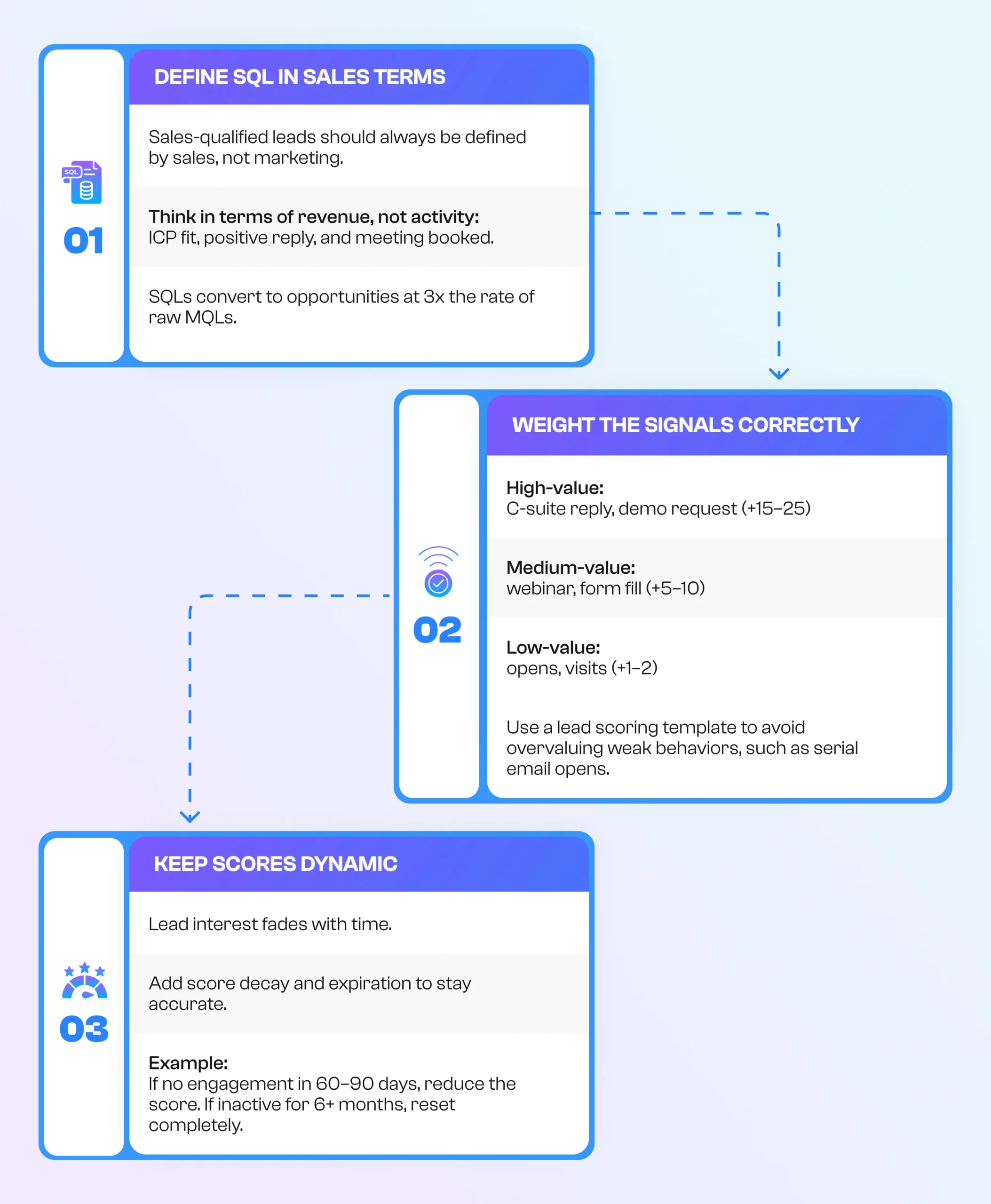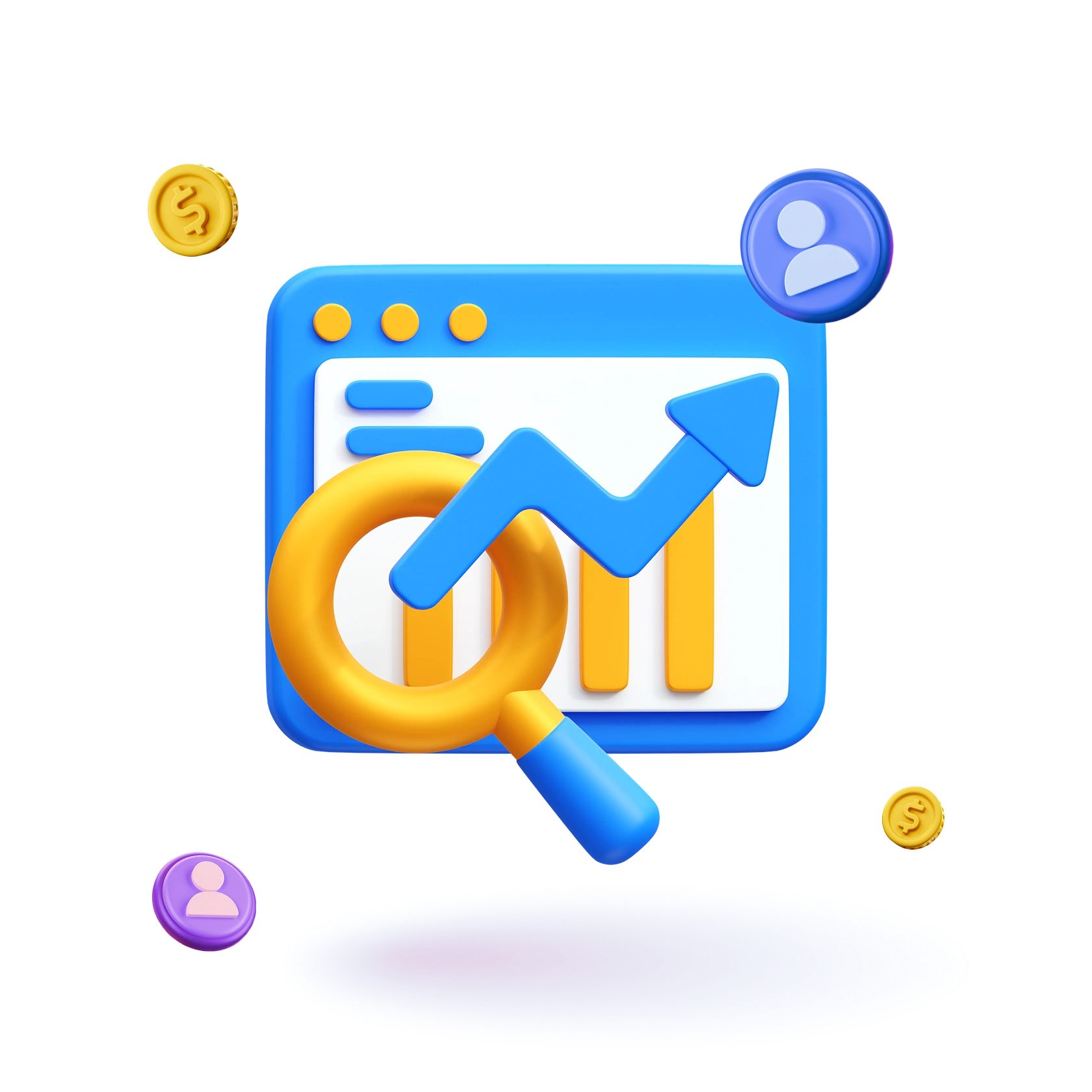Every SDR team has been there: hundreds of names neatly sitting in the CRM, but only a few will ever reply, and even fewer will sign a contract. The real challenge? Figuring out which ones deserve your attention before you burn hours chasing dead ends.
That’s where lead scoring comes in. If you’ve ever felt overwhelmed by sheer volume, you already know how vital it is to separate genuine opportunities from noise. Without it, your pipeline fills up with activity that looks good on paper but delivers little in revenue.
And you’re not alone in feeling this pressure. 42% of salespeople report that prospecting and qualification are their biggest challenges. That’s nearly half of the industry openly admitting that they’re losing time, energy, and deals because they can’t confidently identify which leads are worth pursuing.
At SalesAR, we’ve been in those trenches too. What we share here is the framework that has consistently turned outreach into sales-qualified appointments, even in the toughest markets.
Why Lead Scoring Matters in B2B Sales
Imagine two SDRs on the same team. One dials down a random list of contacts, hoping someone eventually picks up. The other starts with the top 20% of leads — the ones most likely to buy, based on fit and engagement signals. Who’s going to hit quota faster? The answer is obvious, but too many teams still operate like the first SDR, burning hours on names that will never convert.
The cost of misaligned leads is bigger than missed calls. It shows up as wasted hours, bloated pipelines full of “maybe someday” contacts, and frustrated AEs forced to sit through meetings with prospects who were never serious buyers. Over time, that drag compounds, slowing down your entire sales cycle.
SalesAR Insight: Companies with a well-defined B2B lead scoring model see a 77% higher ROI from lead generation. That’s the direct result of prioritizing the right conversations at the right time.
From our campaigns at SalesAR, one thing is clear: B2B lead scoring is about prioritizing the right ones. It’s about ensuring that the right leads progress and become sales-qualified appointments. Once you apply that discipline, your pipeline starts working for you, rather than against you. And that’s when outbound becomes sustainable, repeatable, and quota-hitting.
See how SalesAR’s omnichannel approach can deliver results.
The Evolution of Lead Scoring Models
The lead scoring process has evolved significantly from its origins in simple spreadsheets. What started as a points game has grown into structured frameworks and, for some teams, AI-driven systems. Each lead scoring model has its strengths and its blind spots. Let’s walk through the ones we see most often in B2B.

Point-Based Models
This is the most straightforward approach. You assign points for actions and attributes: +10 for a job title match, +20 for a demo request, -5 for a generic email domain. Once a contact crosses a certain threshold, they’re flagged as “qualified.”
It’s easy to adopt, but it can also mislead. For example, a prospect might accumulate points simply by opening every email, even if they never intend to make a purchase. If your scoring overvalues those weak signals, you’ll pass unqualified leads to sales and frustrate your AEs.
Fit + Engagement Matrix
One of our clients had a recurring issue: their SDRs chased a flood of “interested” leads who were an entirely wrong fit. They’d respond to outreach, maybe even take a call, but they’d never have budget or buying power.
To fix this, we built a two-axis matrix: Fit (A–D) and Engagement (1–4). An A1 lead was a decision-maker at an ideal company who was actively engaging. A D4 lead? Wrong industry, no authority, no interest. Overnight, the SDRs could prioritize who was both ready and relevant.
Predictive / AI-Driven Models
For larger, mature sales orgs, predictive lead scoring adds another layer of intelligence. Instead of assigning static values, predictive models learn from your own history of closed-won vs. closed-lost deals. They analyze thousands of attributes and behaviors to predict which new leads most resemble your best customers.
We’ve seen predictive models shine in teams with robust CRM data and disciplined sales processes. For others, the most significant gain still comes from something simpler: aligning lead scoring with how your sales team defines a qualified lead.
The Signals That Truly Matter for Sales
Every B2B lead scoring model needs fuel, and that fuel is signals. Not all signals are equal; some show a prospect is worth every second of your time, while others say “don’t bother.” The trick is separating the non-negotiables from the noise.
Fit Signals (the non-negotiables)
Fit is the foundation, and well-defined lead scoring criteria make sure everything else doesn’t fall apart. The prospect can open every email you send, but if they’re a freelancer outside your ICP, they’re not going to close. Strong fit signals include:
- Company size — Do they have the resources to buy?
- Industry — Is it aligned with your solution?
- Budget — Can they realistically afford what you offer?
- Buyer role — Are you talking to a decision-maker or an intern?
In our campaigns, we assign negative scores to students, freelancers, and companies that don’t match the ICP. This single filter saves dozens of wasted calls each week, keeping SDRs focused on opportunities with real potential.
Engagement Signals (the intent triggers)
Once you confirm fit, engagement tells you whether timing is right. A decision-maker might be perfect on paper, but unless they’re leaning in, they’re not ready. Engagement signals we prioritize:
- Positive replies — Even a polite “not now” beats silence.
- Booked meetings — A clear sign of intent.
- Demo attendance — Shows time investment, not just curiosity.
SalesAR Insight: Leads that engage with 3+ touchpoints are 2.5x more likely to convert. That could mean an email reply, a webinar registration, and a case study download. The more consistent the engagement, the higher the likelihood they’ll move to the opportunity.
The SalesAR Playbook: Building Your Scoring Logic
When we set up a new client’s campaigns, the first question we ask is simple: What does a sales-qualified lead look like in your world?
If sales and marketing can’t agree on that definition, no amount of points, AI models, or tools will fix the scoring system. The B2B lead scoring logic has to start with alignment — otherwise, SDRs chase noise, AEs lose trust, and the system collapses.

Define SQL in Sales Terms
The definition of an SQL should always come from sales, not marketing. Marketing tends to think in terms of activity; sales thinks in terms of revenue. That’s why an SQL is often something like: ICP fit + positive reply + meeting booked. It’s the combination of fit and intent that makes a lead truly sales-ready.
The difference is measurable. According to Forrester, leads classified as SQLs convert to opportunities at 3x the rate of raw MQLs. That’s the payoff of defining SQLs in more real deals moving through the pipeline.
See how SalesAR’s omnichannel approach can deliver results.
Weight the Signals Correctly
Not every signal carries equal value. A C-suite reply should outweigh a webinar attendance by a wide margin. If everything gets the same points, your behavioral lead scoring will get skewed toward the wrong activities.
Here’s how we break it down in practice:
- High-value signals (C-level reply, demo request, case study ask) — +15 to +25 points.
- Medium-value signals (webinar attendance, form fill, multi-touch engagement) — +5 to +10 points.
- Low-value signals (email opens, website visits) — +1 to +2 points.
And here’s the catch: some signals inflate scores if left unchecked. Email opens are notorious. If someone opens 15 emails, that doesn’t make them 15x more qualified. Our approach involves using a structured lead scoring template to capture repetitive signals and ensure accurate scores. Otherwise, you’ll end up passing “serial openers” to sales and wasting calls.
Keep Scores Dynamic
Lead interest isn’t permanent. If your scoring logic treats a click from 18 months ago the same as one from last week, you’re working with stale data.
We once audited a client whose CRM tracked scores indefinitely. SDRs were chasing people who’d last engaged a year and a half earlier; their connect rates were low. Once we added score decay (subtracting points as time passed) and expiration dates on engagement, their SQL-to-opportunity ratio doubled within a quarter.
The rule is simple: if a lead hasn’t engaged in the past 60–90 days, their score should decay. And if they’ve been inactive for six months? Reset them. Freshness matters as much as fit.
Operationalizing Lead Scoring for Sales Teams
A scoring model only works if your team sees it, trusts it, and uses it every day. That means integrating it into the sales process, rather than hiding it in a spreadsheet. Here’s how to make it stick:
- Show scores in the CRM. With automated lead scoring, HubSpot or Salesforce can display scores clearly on each contact record. If reps can’t see it at a glance, the system won’t get used.
- Trigger tasks automatically. Once a lead passes a threshold, the CRM should create a task or send an alert to the SDR. This prevents hot leads from sitting idle.
- Segment cadences by score. High-scoring leads go straight into an immediate outbound sequence or direct call. Lower-scoring leads are moved into nurture campaigns until they demonstrate stronger intent.
- Close the loop with feedback. Reps flag leads that looked qualified but failed in practice. That data flows back into the scoring model, refining it with every cycle.
At SalesAR, we’ve learned one thing: the model isn’t finished until sales reps say, “Yes, these are the right people to talk to.” With visibility, automation, segmentation, and feedback working together, AI lead scoring becomes a practical guide that keeps the pipeline clean and revenue-focused.
Conclusion
We’ve run thousands of campaigns, and one thing is clear: the scoring model you start with won’t be the one you end with. Buyer behavior changes, markets shift, and the signals that matter today may not matter tomorrow. The best sales teams treat lead scoring as a living system refined by sales feedback and measured by real results.
Start by auditing your model through the lens of sales. Ask your reps: Do these scores match the leads you want to talk to? If not, it’s time to adjust. Done right, lead scoring will accelerate your pipeline and keep your team focused on what matters.
SalesAR can design the omnichannel pipeline that keeps your sales team winning.


